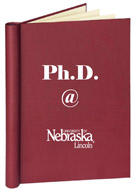Graduate Studies, UNL

Dissertations and Doctoral Documents, University of Nebraska-Lincoln, 2023–
First Advisor
Yongfeng Lu
Second Advisor
Jean-Francois Silvain
Degree Name
Doctor of Philosophy (Ph.D.)
Department
Engineering (Computer and Electrical Engineering)
Date of this Version
7-2024
Document Type
Dissertation
Citation
A dissertation presented to the faculty of the Graduate College of the University of Nebraska and the Graduate College of the University of Bordeaux, France in partial fulfillment of requirements for the degree of Doctor of Philosophy
Majors: Electrical and Computer Engineering AND Physical-Chemistry of Condensed Matter
Under the supervision of Professors Yongfeng Lu and Jean-Francois Silvain
Lincoln, Nebraska, July 2024
Abstract
With the trend towards miniaturization of electrical equipment and the constant increase in power density in semiconductor devices, efficient heat management has become a major concern for researchers. Indeed, this technological evolution imposes increasingly strict constraints in terms of thermal dissipation, necessitating innovative solutions to ensure better durability and reliability of components. In this context, the use of composite materials offering high thermal conductivity (TC) and low coefficient of thermal expansion (CTE) compared to pure metals has become essential to address overheating issues in electronic components.
The utilization of advanced materials such as diamond (D), with exceptional TC and hardness properties, stands out as a preferred choice for reinforcing metal matrices. However, its incorporation into composite materials requires the creation of a well-defined D-metal interface, both to avoid porosity formation and to ensure efficient transfer of thermal properties. Additive manufacturing of three-dimensionally (3D) printed materials by laser fusion is emerging as a promising solution, not only for the ease of implementation of these composites, but also for the creation of complex structures dedicated to heat dissipation. These structures play a crucial role in optimizing the heat exchange surface by convection with the surrounding air, thus allowing efficient dissipation of heat generated by modern electronic devices.
In this study, 3D printing of copper (Cu) was achieved through the addition of an optimal amount of aluminum (Al). This approach significantly improved the densification of copper-based materials, despite the challenges posed by its high reflectivity. Subsequently, in-depth investigation and optimization of laser 3D printing of the AlSi10Mg alloy, before and after the incorporation of D, were carried out. Finally, a crucial post-processing step was optimized, consisting of laser ablation polishing of Al/D composite materials.
This work was carried out as part of an international collaboration between the University of Nebraska-Lincoln in the United States of America, and the University of Bordeaux in France.
Advisors: Yongfeng Lu and Jean-Francois Silvain
Recommended Citation
Kraiem, Nada, "Laser 3D Printing of Diamond-Based Composite Materials for Thermal Management Applications" (2024). Dissertations and Doctoral Documents, University of Nebraska-Lincoln, 2023–. 157.
https://digitalcommons.unl.edu/dissunl/157
Included in
Condensed Matter Physics Commons, Hardware Systems Commons, Materials Science and Engineering Commons


Comments
Copyright 2024, Nada Kraiem. Used by permission